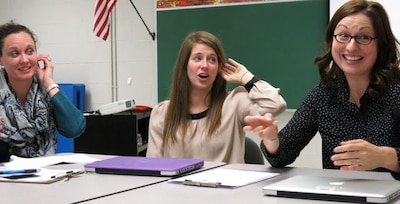Fourth-grade math teachers Lydia McGuire and Heather Floyd observe as colleague Angela Levin presents a lesson on equivalent fractions to her students at Collierville Elementary School. They watch closely to examine how Levin teaches and uses examples to illustrate her points.
The goal is to gauge whether the majority of Levin’s students can explain what they just learned and, if not, how the lesson could be improved.
The practice of teachers observing teachers is part of the Teacher Peer Excellence Group, or TPEG, now in its second year at the school in Collierville, a community of 44,000 people near Memphis. The pilot program is being shepherded in six Tennessee school districts by researchers at the Vanderbilt Peabody College of education and human development in Nashville. It was adapted from methods used in Shanghai, China, home to some of the world’s top-performing schools.
Through financial support from the Tennessee Department of Education and the Bill and Melinda Gates Foundation, 18 school principals traveled to China in 2013 to observe the country’s teacher peer support program. During the 2013-14 school year, the principals implemented the TPEG model in elementary and middle school classrooms in urban and rural school districts in or near Memphis, Nashville and Knoxville. Researchers at Peabody have been monitoring the program’s progress.
“The model stems from Asian cultures that revere elders, respect expertise and value collective wisdom, and that carries over to the classroom, where teachers learn from each other and benefit from one another’s experience,” explained Xiu Cravens, Peabody’s associate dean of international affairs. “This model creates a supportive environment in which new or struggling teachers are quickly brought up to the level of their peers.”
In Collierville, Levin, McGuire and Floyd follow the TPEG model and share a common planning time to develop lesson plans and teaching methods. They take turns observing each other teach without the pressure of the feedback counting toward formal teacher evaluations that affect their tenure and pay. In fact, the teachers say the peer observations help them better prepare for the classroom observations that eventually will be conducted by their principal or a designated administrator as part of their evaluations. And Collierville administrators say participants in the pilot program are scoring higher on their teacher evaluations because of the additional support.
As more school districts use teacher classroom performance to make pay and tenure decisions, more school districts should seek opportunities to support teachers without any high-stakes decisions tied to the support process, said Sandi Jacobs, vice president and managing director for state policy at the National Council on Teacher Quality.
“If a teacher knows a performance evaluation has consequences, that makes it terribly uncomfortable,” Jacobs said. “Instead, they should have multiple opportunities to receive good, useful feedback. If an observation can identify a teacher’s weaknesses –how they can improve them – that’s helpful. It’s also helpful that teachers are encouraged to help each other. Everyone wants to be better than what they are.”
Common ground
Levin, McGuire and Floyd have 32 combined years of experience in the classroom.
“We do get along. That’s important in order for this to work,” McGuire said. “We all know going in that the goal is not ‘how can I make Angela Levin into a Lydia McGuire,?’ but ‘how can I help Angela Levin be a better Angela Levin?’”
For TPEG to work, teacher participants must commit to the joint preparation process, which can be time-consuming as they share practices that work and develop improvement strategies.
All three teachers bring various strengths to the table – Levin is most likely to use technology, for instance. All of them, however, are avid researchers and bring instructional ideas to their weekly pre- and post-observation meetings. The biggest challenge, they say, is arranging for substitutes to cover classrooms when the teachers are observing each other.
“It’s not easy being out of your classroom, but leaving the classroom [for TPEG] has been beneficial,” McGuire said.
Following a checklist they created, McGuire and Floyd sit with Levin’s students while Levin teaches and occasionally walk around the classroom taking notes for review after class. Was the teacher’s communication concise? Was it confusing? Did Levin open with visuals to establish the purpose of the lesson? Did she model the thinking process and demonstrate what is expected of her students?

To an outsider, it sounds like a lot to think about, but the checklist is anchored in one main objective, which makes the observation process less overwhelming.
“We plan the lessons together and we think about how we’re going to hit all the standards and do well in our focus area,” Levin said.
Tracking progress
Since the introduction of teacher peer observations at Collierville Elementary, evaluation scores of its participants have increased. During the 2012-13 school year, the school’s average teacher evaluation score was 3.92 out of a possible 5. One year later, the school’s average teacher evaluation score had increased to 4.29.
“After the first year, we knew it was working,” said Louise Claney, the school’s former principal who is now the municipal district’s director of curriculum and accountability.
Collierville administrators are tracking student test results and teacher observation scores to measure how much the additional peer support is helping teachers improve. In the meantime, the school has expanded TPEG to its fifth-grade reading and language arts teachers.
Some districts participating in the pilot program implemented it full-scale while others moved incrementally. Researchers seem to advocate the latter approach.
“We’re still in the pilot stage and we want to take it deeper before it goes wider,” Cravens said. “Teachers have to want it and be able to adapt it. It’s really important not to push it because when it’s mandated, it doesn’t work.”

